What Eats A Mountain Goat?
Categories
- Accipitridae (1)
- Acrididae (1)
- Algae (2)
- Alligatoridae (1)
- Amoebidae (1)
- Amphibians (3)
- Anatidae (1)
- Anguillidae (1)
- Arachnids (2)
- Bears (2)
- Big Cats (3)
- Birds (13)
- Bovidae (5)
- Bufonidae (1)
- Camelids (1)
- Cameras (1)
- Canines (13)
- Caridea (1)
- Carnivora (10)
- Castoridae (1)
- Cats (5)
- Cebidae (1)
- Cephalopod (1)
- Cervidae (2)
- Cetacean (1)
- Chondrichthyes (1)
- Crocodilia (2)
- Crustaceans (4)
- Culicidae (1)
- Cyaneidae (1)
- Dasypodidae (1)
- Dasyurids (1)
- Deer (1)
- Delphinidae (1)
- Desktop (1)
- Didelphidae (1)
- Dinosaurs (1)
- Dogs (13)
- Dolphins (2)
- Echinoderms (1)
- Education (10)
- Elephantidae (1)
- Equine (1)
- Erethizontidae (1)
- Erinaceidae (1)
- Farming (1)
- Felidae (5)
- Fish (5)
- Food Chain (31)
- Food Web (2)
- Formicidae (1)
- Frugivore (1)
- Gaming (1)
- Gastropods (1)
- Giraffids (1)
- Great Apes (2)
- Health Conditions (3)
- Herbivore (4)
- Hi-Fi (1)
- Hippopotamidae (1)
- Hominidae (1)
- Insects (10)
- Invertebrates (2)
- Keyboards (1)
- Laptops (1)
- Leporidae (1)
- Mammals (23)
- Marsupials (4)
- Mephitidae (1)
- Microchiroptera (1)
- Mollusks (2)
- Mongoose (1)
- Muridae (1)
- Nocturnal Animals (1)
- Odobenidae (1)
- Omnivore (2)
- Phasianidae (1)
- Phocidae (1)
- Plankton (1)
- Plants (2)
- Primate (1)
- Ranidae (1)
- Reptiles (7)
- Rhinocerotidae (1)
- Rodents (5)
- Salamandridae (1)
- Scarabaeidae (1)
- Sciuridae (2)
- Sharks (1)
- Shellfish (1)
- Sound (1)
- Spheniscidae (1)
- Suidae (1)
- Superfamily Papilionoidea (1)
- Theraphosidae (1)
- What Eats (5)
Ever thought about what eats a mountain goat? Mountain goats live so close to the clouds that most predators, or natural enemies, that want to catch one have a long climb ahead of them.
Wolves and cougars are the two main predators of mountain goats. Grizzly bears also occasionally attack them.
In addition, golden eagles have been known to knock baby mountain goats off of mountain ledges. The baby goats are killed or seriously injured in the fall, and then the eagles are able to eat them.
And, what does a mountain goat eat? Mountain goats are browsers, which means that they eat a variety of leaves and other vegetation.
Table of Contents
Toggle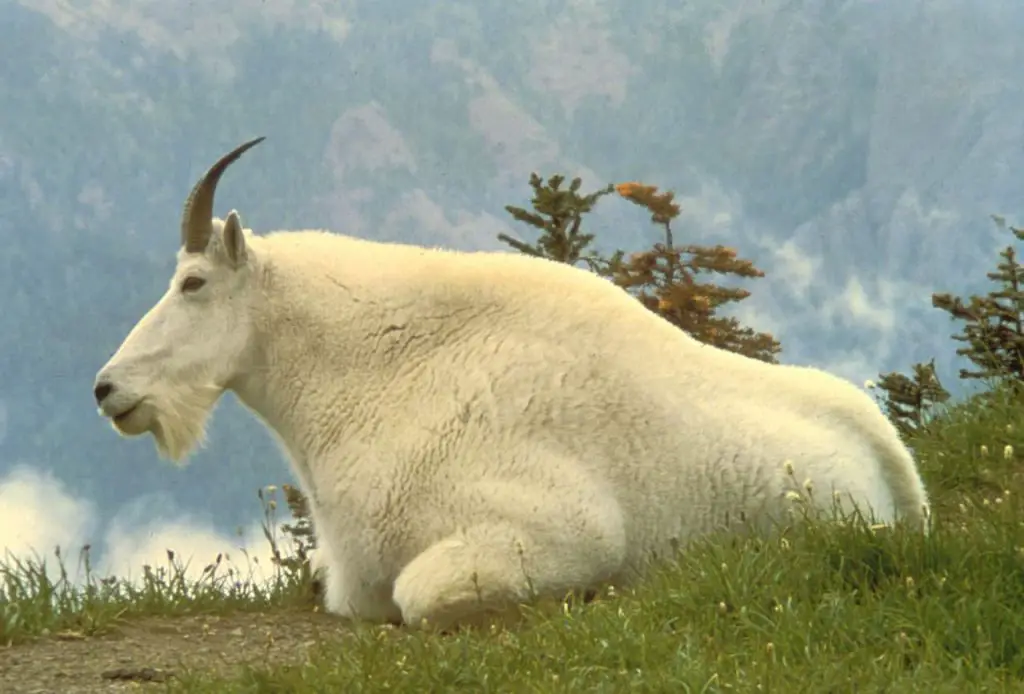
Introduction
Mountain goats are charming animals found in North America’s wild, high-altitude regions. They have an incredible ability to climb and are robust under challenging environments. In their native environment, these graceful creatures fight with various difficulties, including the persistent danger of predators.
Mountain goats live in a world where they constantly fight off fierce enemies to survive, including wolves, cougars, bears, and golden eagles. In spite of these threats, mountain goats have incredible protection and survival mechanisms. Their varied plant-based diet shows how adaptable they are to their hostile surroundings.
In this extensive guide, we will learn in depth about mountain goats’ natural predators, survival strategies, diet, and feeding adaptations.
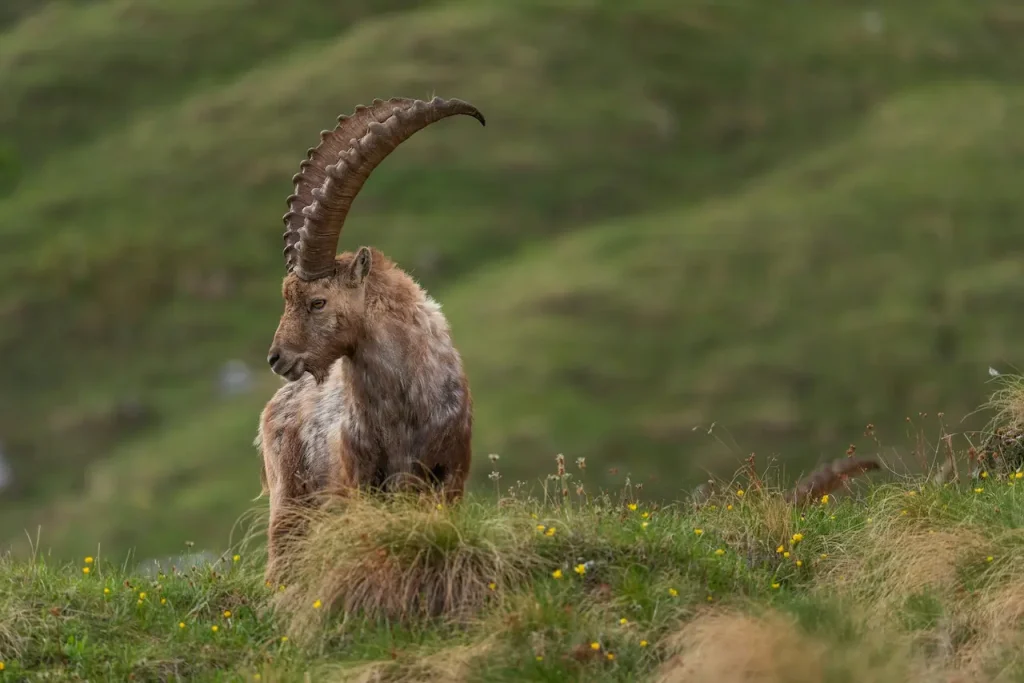
Alpine Ibex Mountain Goat High In The Mountain Alps
What Eats A Mountain Goat Predators
1. The Wolf
Wolves significantly make decisions on how mountain ecosystems function, especially how they interact with mountain goats. Since wolves and mountain goats dwell in rough regions, their interactions are often unpredictable.
Wolves are skilled hunters who use collaboration and well-planned tactics to take down prey that is considerably bigger than them.
Wolves usually target the weaker members of the mountain goat population, such as young or wounded goats that have been isolated from the herd’s protection. In spite of their extraordinary agility and adeptness at overcoming the rocky slopes and sheer drops, mountain goats cannot protect themselves from wolves’ unstoppable hunt.
Alone or solitary Goats might become targets of a wolf pack’s ambush, especially in places with few escape routes.
But mountain goats are challenging targets for wolves. Their strong protection against wolf assaults comes from their quick senses, sound footing, and capacity to withdraw to inaccessible rock ledges.
Mountain goats have complex habits and adaptations to reduce their danger and prosper in their alpine environments. While occasionally preyed upon by wolves, mountain goats and grey wolves interact intricately, highlighting the complexities of predator-prey dynamics in the wild.
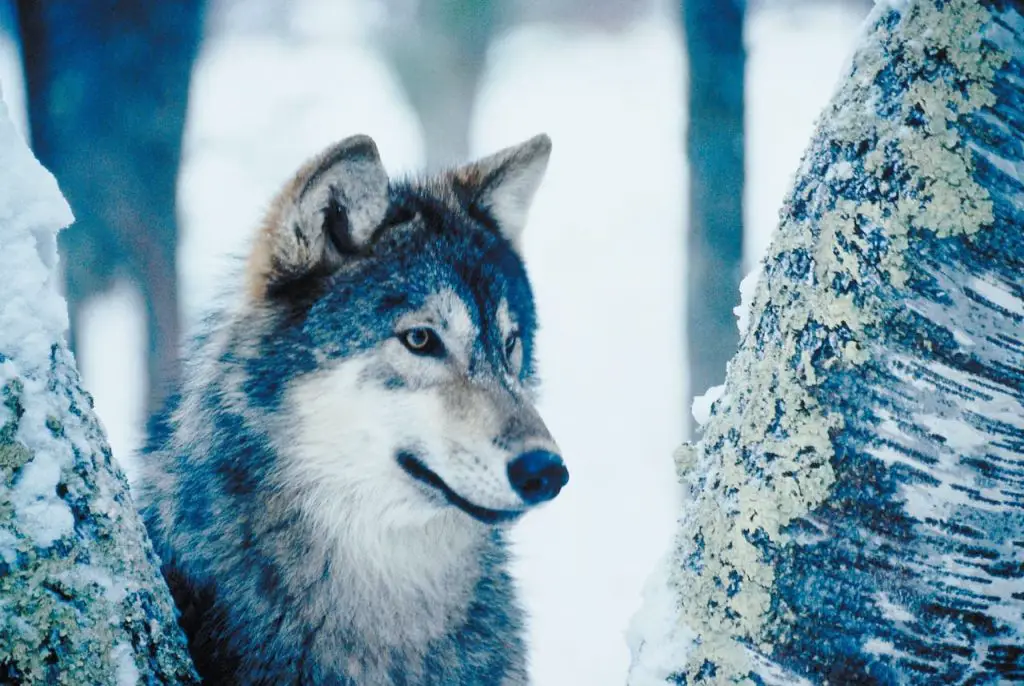
What Eats A Wolf What Do Wolves Eat
2. The Bear
Bears are a predator of mountain goats in some mountain areas. Their primary diet comprises plants, berries, and small animals; however, they prey on mountain goats significantly, mainly during particular seasons.
Mountain goats could be the target of active grizzly bear hunts in spring when they are weakened from injury from passing over rugged areas or giving birth.
However, mountain goats may encounter and lose a battle against more decisive and deliberate grizzlies, which may be life-threatening. A grizzly bear’s solid jaws and razor-sharp claws make it a robust opponent for prey more significant than itself, like a mature mountain goat.
This interaction of mountain goats and grizzlies illuminates the equally tricky relationships between predators and prey in the wilderness. How these skilful animals make ends meet often relies on their strength, agility, and quickness.
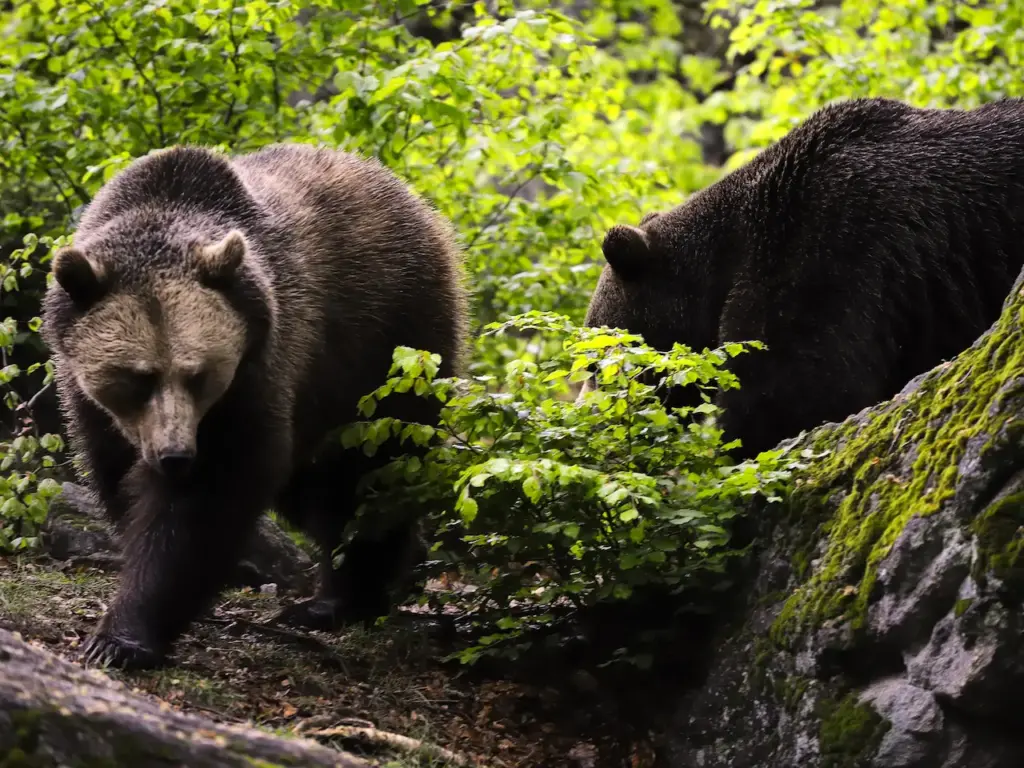
Two Bears Near The Tree What Eats Bears
3. The Cougar
Due to its alpine habitat, the mountain goat’s main predator is the cougar, commonly known as the puma. The cougar’s aggressive hunting method is the main reason for its swiftness and secretiveness in these rough mountains with mountain goats.
Cougars are opportunistic predators because they usually ambush their prey from the shelter of thick greenery areas or rocky outcrops. Even though mountain goats have exceptional climbing skills and strong horns, cougars are a severe threat, especially to weaker ones like young, wounded, or old goats.
Cougars deliberately hunt mountain goats when there is a shortage or when there are few other prey options. They rely on their exceptional stalking abilities and powerful leaps to capture their victims successfully.
Mountain goats and cougars frequently engage in violent and deadly encounters that emphasize the ongoing battle for existence in the hostile alpine environment.
Because cougars influence the behaviour and dispersion of mountain goat populations, they highlight the intricate dynamics of predator-prey interactions in alpine environments.
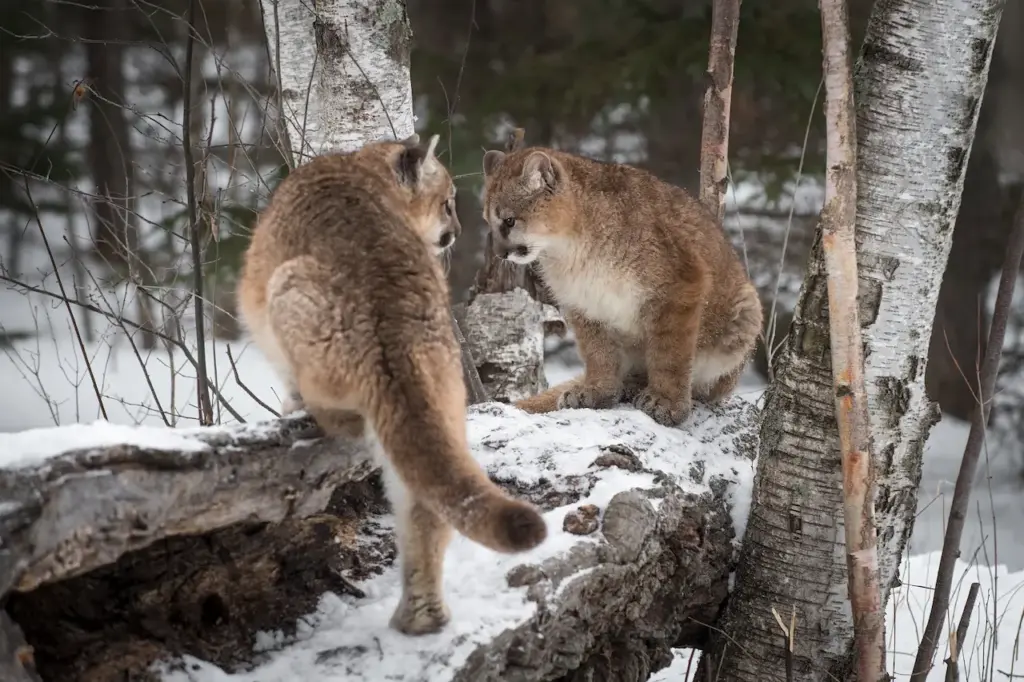
Two Cougar On the Log Playing What Eats A Cougar
4. The Golden Eagle
The golden eagle, highly renowned for its beautiful appearance and impressive hunting skills, is a significant predator of mountain goats and mainly focuses on young, weaker animals.
Due to their seven-foot wingspan and strong talons that are responsible for applying immense force, golden eagles are capable of seizing prey in the rough parts of mountainous areas.
Because of their acute vision, these predators can see mountain goats from a considerable distance as they hunt along the ledges and cliffs. Golden eagles hunt with stealth and accuracy, frequently making quick air assaults to grab incautious, endangered prey.
Adult mountain goats are usually too big and elegant for golden eagles to prey on. Still, their young are easy to grab, especially in the spring and summer when they are most active and noticeable.
Even though mountain goats are excellent climbers, the golden eagle’s aerial skills highlight predators’ ongoing strain on the problematic alpine habitat.
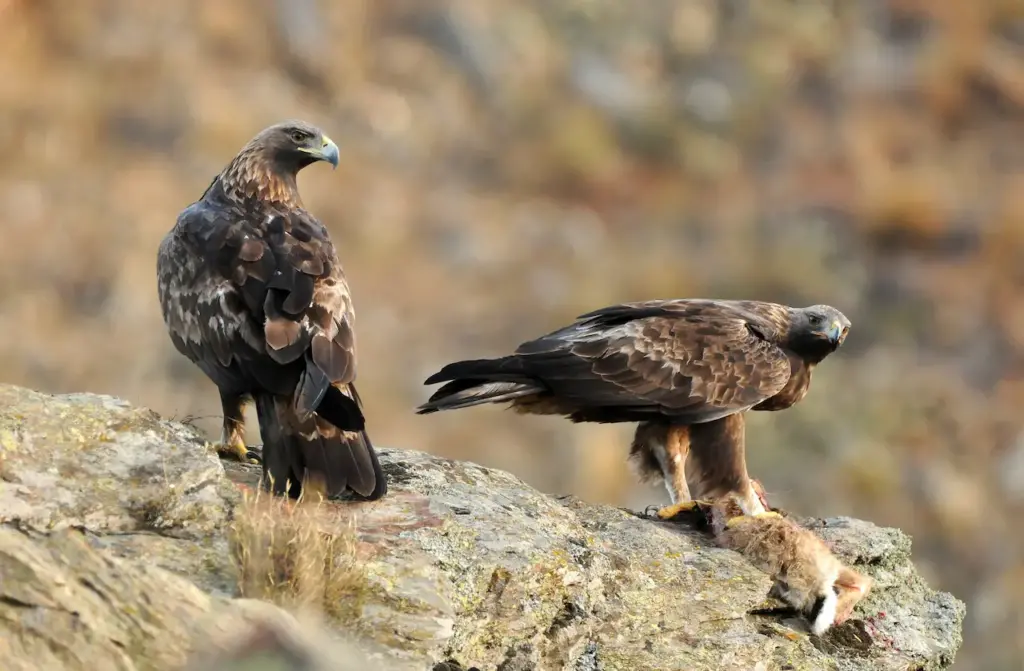
A Pair Of Golden Eagles
Strategies for Survival
Mountain goats have a number of survival techniques to withstand the hazards they experience in their harsh habitat. Their habits and adaptations enable them to avoid the threats that come from their predators.
Agility and Climbing Abilities
Mountain goats are well known for their extraordinary cleverness and aptitude for climbing. With the help of their strong leg muscles and sharp hooves, they can easily climb rugged and abrupt areas, avoiding predators and reaching food supplies that are out of reach.
Their ability to move quickly is essential to survival since it lets them get over the rugged regions and eat where other animals can’t. A key element of their survival strategy is their agility, which also aids in their escape from predators.
Herd Behavior
Mountain goats frequently roam in herds in the form of group security. Herd behaviour enables them to share resources, take better care of their young ones, and identify and react to dangers more skillfully.
Their ability to cooperate to ward off predators and locate food in locations where lone goats may find it difficult increases their chances of surviving in the wild. Because herd behaviour gives them a sense of solidarity and security, it is essential to their survival strategy.
Alertness and Vigilance
Mountain goats monitor their environment closely for hazards. Their acute sense of awareness enables them to identify predators at a distance and alert the herd to potential threats.
Their ability to recognize and react to hazards before they get too near is essential to survival. They may also keep aware of their environment and avoid threats by using their vigilance to choose the best paths to food and refuge.
Defensive Behavior
Mountain goats do not back down from danger. Their muscular bodies and razor-sharp horns repel predators and protect their herd. When they cooperate, they can neutralise hazards and keep their group safe. They use defensive behaviour to shield their herd and themselves from predators and other threats, which is an essential part of their survival strategy.
What Does a Mountain Goat Eat?
Now we have learnt about ‘what eats a mountain goat’, now lets learn about what they eat. After discussing mountain goats’ predators and their strategies for survival, here, you’ll be aware of what mountain goats eat and their adaptations for feeding.
Since mountain goats are herbivores, their main diet consists of plants. They acquire the nutrition they need to survive in their harsh environment from various plants that grow in their high-altitude habitats.
Mountain Goat’s Diet
Mountain goats consume various plant-based meals, including grasses, herbs, shrubs, mosses, and lichens. Let’s explore the details of a mountain goat’s diet and how they survive in their abrasive environment.
Herbivorous Nature
Mountain goats are herbivores, meaning that their main food source is vegetation. Their primary food source is grasses, which are plentiful in their hilly environment. These hardy creatures evolve to feed on rough mountain grasses, breaking down fibrous plant material with their powerful jaws and teeth. In addition to grasses, mountain goats eat a wide range of different plants in their surroundings.
Shrubs and bushes’ leaves supply vital nutrients that support the goats’ general health and well-being. Mountain goats are skilled at finding and eating various food sources despite the rugged areas, revealing their exceptional foraging skills and adaptation to their harsh environment.
These plants provide a wide variety of minerals and tastes, adding extra nourishment to the goats’ diet. Mountain goats are incredibly nimble and inventive when reaching these food sources, often scrambling up steep slopes or dangerously hanging on rocky ledges to reach nutrient-rich vegetation despite the challenging environment.
Foraging is essential for mountain goats to survive in their hilly habitat. In pursuit of food, these agile climbers make their way down sheer cliffs and rocky outcrops, using their sharp hooves, senses and sound footing to identify patches of plants.
Consuming Lichens and Mosses
Mountain goats eat moss and lichen in addition to grasses and bushes since these plants grow well in their hilly environment. These unassuming plants are essential to the goats’ diet because they supply moisture and vital nutrients in areas with little vegetation.
Since mosses and lichens are so common in mountain goats’ rocky haunts and cliffsides, these hardy creatures have easy access to food supplies. Even though they might not appear like much, mosses and lichens are an essential source of minerals and carbohydrates that enable mountain goats to survive in their harsh surroundings.
Mountain goats show their versatility and creativity by including these frequently disregarded plant species in their diet. They do this by using all food sources in their hilly habitat.
Hydration’s Necessities
Mountain goats need water for survival, just like all other living organisms. These vigorous creatures get water from various sources in their mountainous home, such as snowfall, mountain streams, and springs.
Mountain goats are skilled at finding water sources even in the most inaccessible and challenging regions. They do this by using their sharp senses and environmental awareness. Mountain goats are adaptive in finding water sources, whether a little stream trickling down a slope or a secret spring lavish out from the rocks.
Mountain goats show remarkable environmental adaptability and resilience by consuming vegetation and accessing water sources throughout their mountainous habitat. This highlights the ability of mountain goats to thrive in harsh mountain environments.
Adaptations for Feeding
Mountain goats have unique adaptations that enable them to survive in harsh surroundings and effectively search for food. These modifications improve their capacity to reach and use the variety of plants in their ecosystem as food.
Specialised Hooves
The unique hooves of mountain goats are among its most recognisable characteristics; they are ideal for navigating rough and hilly areas. Their rugged, coarse hooves offer superior grip on slick conditions. Moreover, they have a rubbery, soft pad on the bottom of their hooves that functions as a natural suction cup, making it easy to hold onto rocky outcrops and tight ledges. Because of their unique adaptation, mountain goats can access plants growing on cliffs and travel to dangerous parts of their habitat for food.
Flexible Necks
Because of their exceptionally flexible necks, mountain goats can reach foliage that is high or difficult to reach. Their flexible necks also allow them to access a wide range of food sources, whether bending down to feed on grasses near the ground or extending upwards to munch on the leaves of tall bushes. They are supposed to be able to adapt to maintain a well-rounded diet and increase their chances of obtaining food in their hilly habitat.
Thick Fur Coat
Living at a high altitude requires enduring severe weather, such as bitterly cold temperatures and windy gusts. Mountain goats have a thick fur coat that covers them from the cold so they can stay warm and comfortable. Their hair is double-layered, with a more extended, rougher outer layer and a thick, fluffy undercoat.
Even in the harshest alpine situations, they stay warm because of this fur mix that helps retain heat close to their body. They can also shake off moisture from rain or snow and keep dry in wet weather since their fur is water-resistant. Because of this adaptation, they can endure the severe circumstances of their alpine home all over the year, which is vital to their survival.
Efficient Digestion
Mountain goats have effective digestive systems that allow them to get the most nourishment possible from their fibrous diet. Their stomachs are divided into many sections, one of which is the rumen, where microbes aid in the fermentation and breakdown of plant matter.
Mountain goats can obtain nutrients from tough plant fibres that would be indigestible to many other animals through fermentation.
In addition, mountain goats’ sluggish metabolic rate enables them to obtain maximum energy from their diet, an essential survival strategy in the energy-deficient alpine environment.
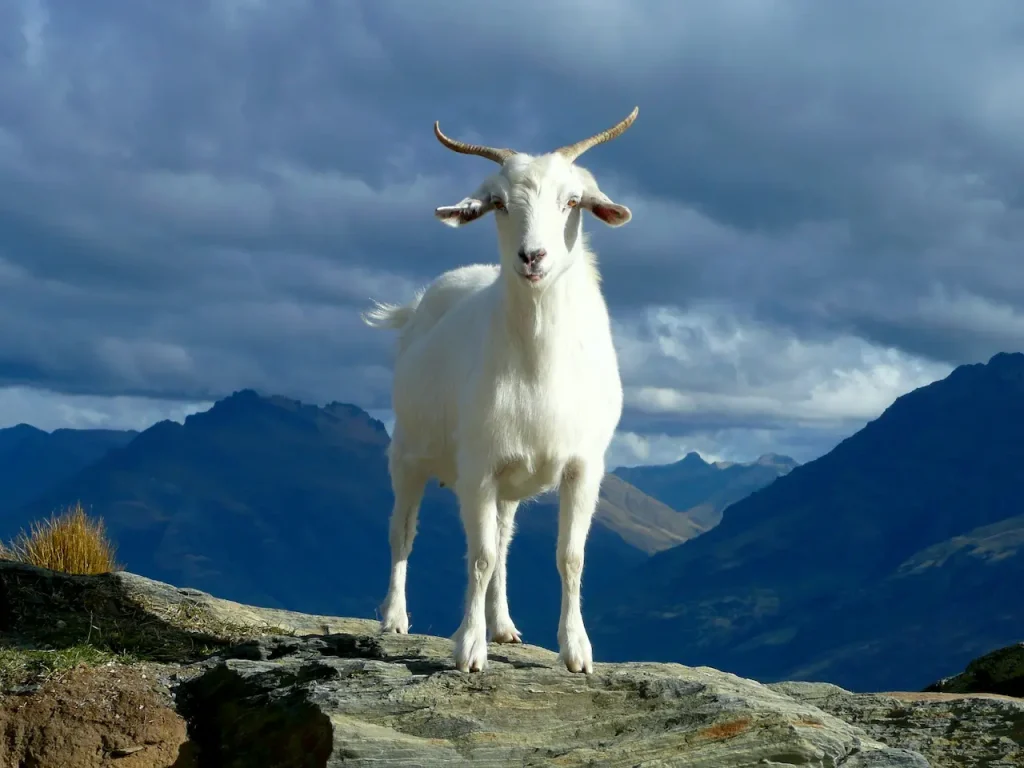
White Mountain Goat In Queenstown
Efficient Water Utilization
Water might be limited in mountainous areas, particularly in dry seasons or higher altitudes when streams can be frozen. To overcome this difficulty, mountain goats have effective water-use techniques. They can obtain moisture from the plants they eat, lessening their dependency on outside water sources.
Furthermore, mountain goats’ highly concentrated urine reduces fluid loss, another way they preserve water. Because of this adaptation, they can survive in arid mountainous areas with little water supply. Mountain goats can stay hydrated and survive in their harsh environment by making the most of the water they use.
Seasonal Variations in Diet
As opportunistic feeders, mountain goats modify their diet in response to seasonal availability and dietary requirements. When flora is abundant in the spring and summer, they mostly eat fresh grasses, herbs, and flowers. In the fall and winter, when the seasons shift, and there is less vegetation, mountain goats may depend more on shrubs and woody plants.
Lichens, mosses, and other non-vascular, cold-weather-resistant plants may also be included in their diet. Because of their adaptability, mountain goats can ensure their nutritional demands are satisfied all year round and adjust to changing environmental conditions.
Final Words
Mountain goats are amazing animals that have to survive in harsh areas. Because of their varied diet, unique physical adaptations, and clever behavioural patterns, they can maximise the insufficient resources in their high-altitude environments. By comprehending mountain goats’ food requirements and evolutionary processes, we may learn about their remarkable flexibility and persistence in the environment.
Although they are threatened by wolves, cougars, bears, and golden eagles, mountain goats have resilience mechanisms, including agility, herd mentality, alertness, and defensive manoeuvres, to help them survive in their harsh environment.
Mountain goats show the remarkable ways in which animals adapt to thrive in their natural habitats and the resilience and resourcefulness of wildlife under challenging environments. This is shown by the goats’ distinctive adaptations and social behaviours.
